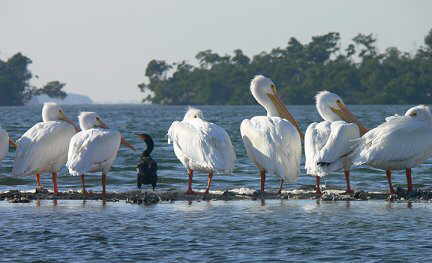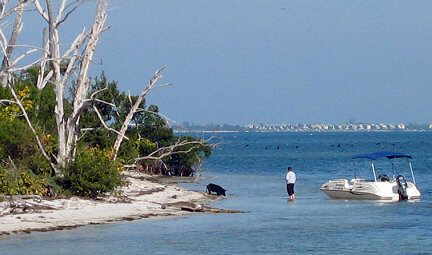
by Keith Rodgers
After the Christmas frenzy has died down, visions of sugar-plums no longer dance in my head – they are replaced by dreams of a kayak gliding over crystal-clear tropical waters and perhaps a lazy wet exit, done just for the pleasure of enjoying the warm sea.
There are many tropical locations promising kayakers this bliss: in my browser I’ve searched from Belize to Thailand and contemplated the merits of semi-permanent camps, platforms in the Everglades or the comforts of a mother-ship anchored off a beach. The problem was that the kayaking itself didn’t look very interesting. Usually a group of happy couples was portrayed, sitting sedately in beamy doubles or sit-on-tops with the text offering reassurances such as, “After a brief paddle in the sheltered lagoon, a beach lunch with jumbo margaritas will be served.” Not that there’s anything wrong with that, of course, but I suspected that for someone who enjoys kayaking in all conditions, and loves the almost hypnotic feeling that settles in as mile after mile is covered, this gentle margarita-fuelled style of kayaking would soon cause me to ask, “Is that all there is?”
Another approach presented itself when I came across a small ad for Coral Island Yachts and Charters (“Mothership tours in Florida and the Bahamas”) with a photograph of what looked like a couple of kayakers in Romanys. A visit to the web-site confirmed that they did indeed feature NDK and Valley products, and I could even have a Greenland paddle if I wanted it. These were obviously serious kayaking folk, so I signed up without further ado and early in February found myself heading south on Interstate 75 through the urban wasteland of North Fort Myers, turning onto Highway 78, across a causeway and then a bridge to Pine Island.
Pine Island is one of those Florida backwaters so far ignored by developers, almost free of condos and pretty well covered with ordinary-looking farms that just happen to be growing mangoes and coconut palms. At the southern tip of the island lies the bizarrely named St. James City, a community of about 60 homes, with a marina and a small fishing pier. It was late afternoon and I was the first of the group to arrive; I waited in the Waterfront Café looking out at grey water under a cool overcast sky; a couple of seagulls looked morosely back at me. The temperature was an unseasonable 62 degrees F and I wondered where my tropical paradise was hiding. Eventually a small shuttle bus drew up, disgorging the six other guests. They consisted of three married couples, all from the northeastern U.S., and all with some kayaking experience. Soon we were joined by John, builder and captain of the Mirage who was to ferry us out in a tiny dinghy to the boat which was to be our home for the next six days. The Mirage was a large catamaran, lying at anchor in the lagoon between Pine and Sanibel Islands. Once on board we met Elke, John’s partner and took our gear down below to our small but comfortable cabins.
That evening, after a terrific dinner of fresh yellow-tail snapper cooked by Elke on the small 3-burner propane stove in the galley, John described the plan, which was to move out in the morning and sail about 12 miles north, past Sanibel Island to anchor in a bay on the lagoon side of North Captiva Island and then spend the rest of the day paddling. The next day, or maybe the day after – it didn’t really matter – we would sail a bit farther north and so on until the end of the trip, when we would turn around and come back to St James City.

Pine Island is about half way down a chain of barrier islands that stretches down Florida’s Gulf coast from Tampa to the Everglades. Between the islands and the mainland is a series of lagoons; usually only a few miles wide, they are long but very shallow stretches of water, about six to eight feet deep at high tide, with sandy bottoms covered with eel-grass and the occasional oyster bank. Through the middle of the lagoon system runs the Intra-coastal waterway, a dredged 100 foot wide channel that’s a sort of marine Hwy 401. This is manatee country, and dolphins, stingrays and nurse sharks could also be expected.
In the morning, filled up with fresh mangoes and French toast, we sipped our coffee and watched as John took the Mirage north up the Intra-coastal. A pleasant surprise was the absence of visible development on Sanibel and Captiva Islands, which have a four-storey height limit, as well as a large wild-life refuge running along most of their eastern coast. After an hour or so the Mirage left the waterway and headed in to a large bay, fringed with mangrove swamps. The tide was going out and soon even the Mirage, which draws only three feet, grounded gently on the sandy bottom a few hundred yards off shore. The boat, designed and built by John for kayak touring, is perfectly at home in these kind of waters, as its main hull and large catamaran-style outrigger pontoon allow it to rest happily on the bottom, level and stable, until the tide floats it off again.
The pontoon, flat-topped and with a freeboard of less than two feet made a perfect spot from which to scramble into the kayaks, which we did, then paddled off to the explore the mangrove swamp that ran for miles along the island. The weather was still cool enough for me to be glad of the lightweight paddling jacket I had thrown into my duffel bag, on top of the tee shirts which I had confidently expected to wear. But the grey overcast was breaking up, the forecast called for a return to sunny skies and in any case, the sea and shore around us was fascinating. As we drew close to the fringe of arching finger-like roots that anchored the red mangroves to the sand platoons of fish – striped sheepshead and sleek grey snook (“good eating”, said John) darted past us in the clear shallows. Flocks of brown pelicans flew overhead, and in the mangroves we soon spotted all four species of heron which live there.
Parts of the mangrove cover were brown and dead – remnants of the effect of the severe hurricane of 2004 – but new green growth was thrusting through it. After a few miles we came across another product of the hurricane, a shallow channel or cut blasted straight across the neck of the island. We paddled through it and out into the blue waters of the Gulf. In the distance a mixed flock of gulls and pelicans were circling over a patch of turbulence. As we drew nearer, we saw it was caused by a large group of dolphins in a frenzy of feeding on a shoal of silver mullet. They snapped at the panicked fish, often just taking out the mid-portion, leaving heads and tails for easy taking by the gulls and pelicans overhead. We landed on a beach of fine silver-sand and walked along looking for rarities in the piles of shells that lay everywhere. In the pine trees along the edge of the beach were several osprey nests, inhabited and busy at this time of year. We ate our snacks and admired the ospreys. Back in our kayaks, we scraped through the shallow and fast-flowing waters of the cut, then back to the Mirage for short but hot showers followed by another wonderful dinner (Portobello mushrooms, buffalo burgers and much else). By 10:30 most of us were in our berths. I fell asleep as the boat, now afloat, rocked almost imperceptibly as small waves slapped against the pontoon.
The next four days followed pretty much the same pattern. The weather cleared and warmed as predicted and my jacket gave way to a paddling shirt. Some days we paddled 10 to 12 miles, taking a picnic with us, on other days we returned to the Mirage for lunch, when the plentiful wine and beer would usually result in a lazy afternoon. My fellow guests revealed themselves as interesting people and friendships quickly formed. The paddle routes were long enough to tire us pleasantly, but the conditions were rarely challenging. Once we had to cross the busy Intra-coastal Waterway, and as we waited for the right moment two large and fast power boats surged past in opposite directions, causing an impressive combined wake which hit the shallows in which we bobbed, turning instantly into a set of very large waves indeed. We bashed through them in our sporty British boats, whooping with pleasure (well, most of us).
Bird sightings continued – a pair of bald eagles, nesting, egrets and ibises galore, a large flock of white pelicans standing on an oyster bed and squawking at us. And once, a rookery of brown pelicans with the huge birds perched improbably in mangrove trees, which swayed under their bulk. In the water, lots more sheepshead and snook; an occasional stingray but alas, no manatees. One very hot day we explored an abandoned homestead, built on an Indian shell-mound island. All over the island were the footprints of wild hogs, originally abandoned by Spanish explorers. On the last day, watching from the Mirage, just off the beach, we saw two black piglets rooting about under a tree. A father and his two young girls watched them from a respectful distance. As we wondered about the whereabouts of the mother hog the piglets took off. We followed them, cruising around a small point to where a large black pig stood in the shallows looking hopefully at a small boat drawn up on the beach a few feet away. In the boat sat a man drinking a can of beer. He got out of the boat and strolled up to the hog, which opened its mouth and gratefully accepted a swig of the cold beer. Irresponsible no doubt but it seemed to capture something of the spirit of the place and the trip.

If you go: Coral Island Yachts and Charters is operated by John Bartlett and Elke Thuerling. In the winter and spring they run trips along Florida’s Gulf coast, moving to the Bahamas in the summer. Trip details and prices can be found at www.KayakV.com.
